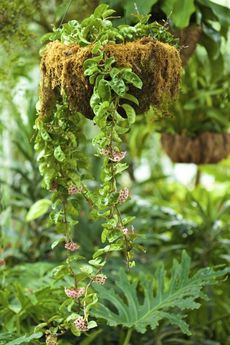Wax Plant Care: Tips On Growing Hoya Vines


Hoya vines are absolutely stunning indoor plants. These unique plants are native to southern India and named after Thomas Hoym, the Duke of Northumberland's gardener and the grower that brought attention to the Hoya. The Hoya climbing vine is easy to care for in most home situations provided they get plenty of indirect light and high humidity. These are long-lived plants that prefer cramped growing conditions. With a little attention and knowledge on how to care for Hoya, these plants can be passed down from generation to generation.
About Hoya Wax Plants
Among the picturesque names for Hoya are wax plant and porcelain flower. This is a tropical plant, best suited to indoor growing in all but the warmest climates. The flowers may be a rarity in home situations but, if you get lucky, the delicate flowers present a perfect display that almost looks too good to be real. Hoya is a terrific plant for a beginner gardener to learn indoor plant care. There are over 2,000 plants in the Hoya genus. That said, Hoya carnosa is the most commonly cultivated for home growing. Interestingly, it is in the Milkweed family, the same family of plants that are the main sustenance for Monarch butterflies. Hoya plants are easily propagated by cuttings. Cuttings root easily in plain water (use rainwater for best results) or with the cut end inserted into African violet soil mixed by half with perlite. In about two years, the cutting will result in a mature plant capable of blooming. The ease of propagation makes growing Hoya vines to give to family and friends almost effortless and enables you to pass along this amazing plant.
How to Care for Hoya Wax Plants
Hoya plants should be kept out of the high light of the day, as this may burn the leaves. They need bright light but indirect. Water the plant frequently enough in spring and summer that the soil is kept moist. Misting is also a good idea unless the plant is kept in the bathroom where shower steam will keep the air humid. There is no need to prune a Hoya; in fact, the tendrils at the ends are where new foliage will grow and flowers develop. The optimum temperatures for wax plant care in the growing season are 65 degrees Fahrenheit (18 C.) at night and 80 F. (27 C.) during the day. Hoya wax plants aren't actively growing in winter but they do need light and water. Provide the plant with bright indirect light in a cool area of the home free of drafts. Remember, this is a tropical plant and it cannot tolerate cold, but temperatures of 50 degrees Fahrenheit (10 C.) will help force the Hoya into dormancy. Hoya in winter does not need as much water as in summer. Wait until the top few inches (5 to 10 cm.) of soil are dry. Mist plants that are near drying furnaces or other heat sources several times a week to increase humidity. Alternatively, the Hoya climbing vine can have its container set on a saucer filled with small gravel and water to increase moisture around the plant without getting its roots sodden. Fertilizing is not part of wax plant care in winter. Mealybugs, aphids, and scale are the pests of most note. Combat with horticultural oil.
Gardening tips, videos, info and more delivered right to your inbox!
Sign up for the Gardening Know How newsletter today and receive a free download of our most popular eBook "How to Grow Delicious Tomatoes."

Bonnie Grant is a professional landscaper with a Certification in Urban Gardening. She has been gardening and writing for 15 years. A former professional chef, she has a passion for edible landscaping.
-
 How To Get Rid Of Mosquitoes In The Garden: 9 Natural Ways To Make Them Buzz Off!
How To Get Rid Of Mosquitoes In The Garden: 9 Natural Ways To Make Them Buzz Off!How to get rid of mosquitoes is on the minds of people in the summer in almost every region of the world. Learn how to repel the pests without toxic chemicals.
By Mary Ellen Ellis
-
 Monkey Orchid Care: How To Grow This Fascinating Species
Monkey Orchid Care: How To Grow This Fascinating SpeciesThe monkey orchid bears a remarkable resemblance to its namesake and, with a little know-how, can be successfully grown as a houseplant.
By Bonnie L. Grant
-
 Hoya Propagation Methods – Tips For Propagating Hoyas
Hoya Propagation Methods – Tips For Propagating HoyasIf you?re interested in wax plant propagation, the most dependable technique is propagation via stem cuttings. Hoya propagation through seed is chancy and the resulting plant likely won?t be true to the parent plant - if the seed germinates at all. Learn more here.
By Mary H. Dyer
-
 Hoya Plant Feeding: How To Fertilize Wax Plants
Hoya Plant Feeding: How To Fertilize Wax PlantsThere are two schools of thought on when to stop fertilizing a wax plant, but almost everyone agrees they need supplemental food during the growing season. Find out when to fertilize wax plants and enjoy these indoor beauties for years here.
By Bonnie L. Grant
-
 No Flowers On Hoya Plant: How To Get Wax Plant To Bloom
No Flowers On Hoya Plant: How To Get Wax Plant To BloomIf there are no flowers on Hoya, it may be that you have one of the non-blooming types or (more likely) some cultural defect is causing the plant to fail to flower. Click this article to find out how to get wax plants to bloom and keep them flowering for years to come.
By Bonnie L. Grant